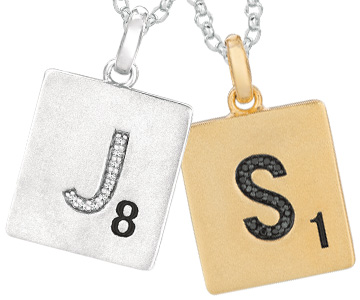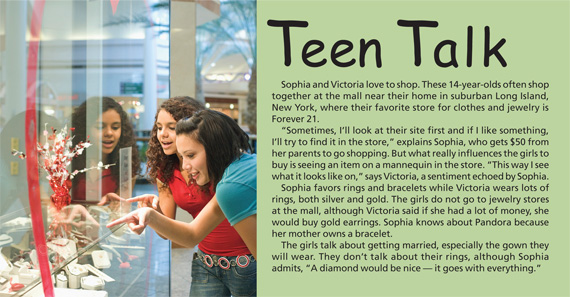|
In-Depth
Teen Time
Tech-savvy teens represent a significant market, but the recession has had a big impact on attitudes and wallets.
By Joyce Kauf

|
|
Scrabble tiles from World Trade Jewelers.
Photos courtesy Lazar Advertising.
|
The teen market is one of contradictions,” says MaryLeigh Bliss, trends editor at Ypulse, a youth marketing agency in New York City. “Teens were raised by Boomers, who taught them to buy, but they have been tempered by the recession, which has influenced their attitudes and buying behavior,” she explains. Still, the teen market represents enormous potential for retailers. In 2012, the purchasing power of 12- to 19-year-olds in North America was estimated at $117.8 billion, while their estimated global spending power topped $819 billion, according to Christina Sommer, vice president, Global Insights group at MasterCard Worldwide, citing TRU Insights, a youth research company in Chicago, Illinois. Other estimates of teen buying power vary. YouthPulse 2012 by Harris Interactive, a market research firm in New York City, estimated a broader youth market at $211 billion on an expanded age range of 8- to 24-year-olds.
The fact that researchers use different parameters to assess “teen” spending power also applies to determining the population statistics. Even the U.S. Census 2010 demographic profile data does not categorize teens; it identified almost 21 million people between the ages of 10 and 14, with another 22 million people between the ages of 15 and 19. Ypulse groups teens with Millennials, those born within the 20-year period between 1982 and 2002. GfK MRI, an international market research firm in New York City, estimates the number of teens in the U.S. at 21 million. Given these numbers and their purchasing power, jewelry retailers have many future customers to attract to their stores.
YOU MUST HAVE JAVASCRIPT ENABLED TO VIEW THE SLIDESHOW
One striking characteristic of this group is their awareness of debt. “The younger Millennials are thinking about college and the debt they will accrue that will take them years to pay off. That makes them very cautious about spending,” says Bliss. The lingering impact of the recession on their buying attitudes is evident in the Charles Schwab “2011 Teens & Money Survey” findings about insights into money attitudes, behaviors and expectations of 16- to 18-year-olds. According to that study:
93% say their family was impacted by the recession.
64% are more grateful now for what they have.
64% say that it is easy to get carried away and spend too much when times are good.
While acknowledging the economic toll of the recession, Sommer finds some positive impact in that teens, like the general population, have become more conscious of how they spend their money. They often ask, “Do I need this?”
Teens’ concern over money is also reflected in the recently released 25th semiannual “Taking Stock with Teens” market research project from Piper Jaffray, an investment bank and asset management firm based in Minneapolis, Minnesota. The survey was conducted among approximately 5,200 teens, with an average age of 16.3 years. Stephanie Wissink, senior research analyst and codirector of investment research at Piper Jaffray, notes, “Spending has moderated across discretionary categories for both upper-income and average-income teens when compared to the prior year and prior season. Yet nearly two-thirds of respondents view the economy as ‘consistent’ to ‘improving,’ and just over half signaled an intent to spend ‘more’ on key categories of interest, particularly fashion and status brand merchandise.”
The analysis showed:
- The fashion category accounts for roughly 40 percent of teen budgets, consistent with prior survey cycles.
- Spending among upper-income teens was down modestly from the prior year and season while average-income teens indicated a slight increase.
- Approximately 53 percent of upper-income teens plan to spend more on fashion apparel in the coming periods.
“Teens are absolutely supported by their parents,” says Bliss. According to the Charles Schwab report, teens typically spend an average of $18.50 per week. Piper Jaffray notes that parent contribution declined by nearly 10 percentage points in their spring survey, with 55 percent to 60 percent of teens indicating their parents contribute more than half of their spending.
Sommer points out that teens under 18 cannot own a credit card, but can be authorized users on their parents’ cards. She noted that debit or prepaid cards are gaining in popularity because they set a contained spending amount. The Charles Schwab report indicates that 42 percent of teens have an ATM or debit account and 33 percent have a checking account.
The Charles Schwab report showed how teens get their money:
67% of teens have some type of a job. Last year, they earned an average of $1,631 from working.
59% said they receive monetary gifts that averaged $239.
34% receive a weekly allowance, on average, of $16 per week.
28% borrow money. On average, they owe $252 to their parents, school or friends.
“For the most part, teens shop where their parents take them, such as Target, Wal-Mart or Kohl’s,” notes Bliss. Sommer points out that showrooming — the concept of going to a brick-and-mortar store to see the merchandise and then buying it online, possibly for less — is growing. This trend is reflected in the Piper Jaffray statistics regarding where teens shop:
- Approximately 79 percent of females and 76 percent of males shop online.
- Approximately 18 percent of their spending is online.
- Nearly 70 percent of teens indicate they prefer to shop the websites of their favorite stores-based retailers.
Attesting to the fact that value has become a factor in their purchasing, Piper Jaffray pointed out that approximately 70 percent of teen girls and 55 percent of teen boys shop at off-price stores and that 55 percent and 42 percent, respectively, indicated it is popular to do so.
“Shopping is now an experience, not just a transaction,” says Sommer. “Teens tend to ‘crowdsource’ their decisions,” adds Bliss, meaning they get the opinions of others, either in person or online. In the Piper Jaffray study, teens cited friends as the strongest influence over their purchase decisions. Wissink points out that the influence of friends has remained constant throughout their survey history, but that the internet is quickly rising in profile. Approximately 53 percent of females and 52 percent of males indicate that social media impact their purchases, with Facebook being the most important, followed closely by Twitter and Instagram. But the popularity of Facebook is waning among teens, with 33 percent citing it as the most important, down from 42 percent six months ago.
Sommer believes teens have a concept of luxury and even at an early age are introduced to prestige brands on gaming apps that they download on their mobile devices. “Teens are brand savvy but they don’t want a brand that is plastered with logos,” says Bliss. Other factors enter the buying equation — especially whether the brand and/or the retailer is charitable. “Supporting a cause they care about resonates with this market,” she adds. “Value translates to social value,” says Sommer.
“Teens are open to new brands and new experiences,” says Bliss. They love discovery and want to be the first to find something. While crowdsourcing is important, they want to be known as individuals,” she notes. “Think of marketing to a segment of one rather than a demographic,” advises Sommer.
“Do not underestimate this generation and this market,” Sommer advises retailers. They are smarter and have the ability to quickly access information. “Technology is shaping what is happening in every aspect of their lives. This is the group that is leading every trend — they have their finger on the pulse,” she concludes.
 Article from the Rapaport Magazine - June 2013. To subscribe click here.
|
|